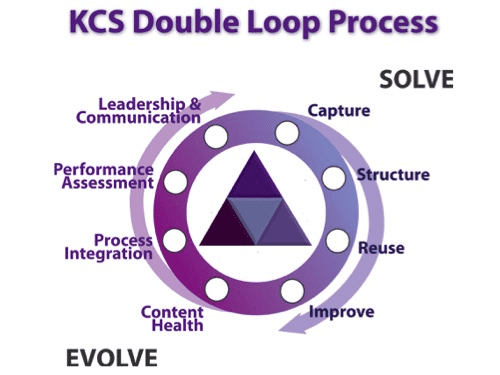An RFP content library (a.k.a proposal library) is a proposal manager’s secret weapon. It stores years of knowledge from everyone who has helped respond to requests for proposals (RFPs). “I like to think of myself as an old, fairytale dragon 🐉 sitting on my treasure trove of information,” says Katherine Allred, Senior Proposal Manager of MX.
But a content library is only valuable if the answers are accurate and up-to-date. And unfortunately, 42% of RFP teams say this remains one of their biggest challenges.
That’s because proposal content management is a cross-functional effort. While proposal managers own the RFP response process, they rely on subject matter experts (SMEs) to contribute (and update) answers. And without their cooperation, a content library can quickly slip from useful to useless…
That’s why Katherine and her proposal team implemented a methodology called Knowledge-Centered Service (KCS). Read on to learn how the this process keeps your proposal content library in good shape with the help of SMEs:
The Solve Loop: Manage Your Proposal Library As You Respond to RFPs
It can be a struggle to get SMEs to dedicate the time and attention an RFP library deserves. That’s why it helps to show them their answers will be valued, cared for, and made reusable.

What’s the KCS Methodology for RFP Content Management?
Developed by the Consortium for Service Innovation, KCS introduces a new approach to proposal content management. Instead of maintaining your content library separately, KCS integrates this process naturally into your existing RFP process flow through two complementary loops:
- The Solve Loop: Create, reuse, and update answers as you respond to RFPs.
- The Evolve Loop: Use insights to evolve content based on demand and usage.

Let’s look at how these loops work together to manage your proposal library effectively.
The Solve Loop: Manage Your Proposal Library As You Respond to RFPs
The first KCS loop deals with your day-to-day work—completing RFPs, issuing content requests, updating answers, and so on. According to Katherine, it’s “reactive,” maneuvering events as they occur, like when an RFP asks a new question. What’s the answer, and where do you save the response for reuse? Or maybe a new piece of legislation passes. How do you update your existing content?
Here’s how Katherine uses the Solve Loop to keep MX’s proposal library running at its best.

(Watch the full Loopicon session or keep scrolling for more videos below.)
Capture Net-New RFP Content
The biggest difference between KCS and other proposal management processes is its immediacy. Instead of documenting answers after the fact, you create, save, and share your RFP content in real-time.
“Save everything new,” Katherine says. “You don’t know if you’ll need an answer again. You may; you may not.”
But capturing isn’t the same as keeping. Although her team saves each new piece of content, they still carry out a regular weeding process. “The solve loop very quickly shows us what’s useful and what’s dead weight,” she says.
Structure Your Proposal Library
“If your proposal library is the heart, then its structure is the backbone,” says Katie Salvoni, Senior Customer Success Manager of Loopio. In other words, structure helps your team navigate and retrieve answers quickly, whereas an unorganized library grows unwieldy—fast.
So, how do you implement this fundamental step in the Solve loop? As you examine the structure, Katie recommends asking four questions:
- Is it intuitive? Put yourself in the shoes of someone new on the team. If they were to see the proposal library for the first time, could they easily find what they’re looking for?
- Is it clear? Take a step back and pick out any category or subcategory names that include acronyms or jargon. These should be recognizable to any library user, regardless of department.
- Is it redundant? Do you have any duplicate or even similar categories that you can merge? What about a subcategory with only one or two entries? Can it fit somewhere else to streamline your proposal library further?
- Is it scalable? As your company grows, you’ll naturally need to house more content. To avoid demolishing and rebuilding the library from the ground up, ensure your structure allows you to slip in new content easily.
Not sure how to structure your proposal library? Download this RFP answer library template to organize your content based on an ideal framework.
Reuse Your Best RFP Answers
With a structured content library, Katherine can quickly find answers from past RFPs and use them again for new requests—even populate them directly into the document using RFP automation software. But reusing old content doesn’t mean shipping boilerplate proposals.
Thanks to a head start, she can use the extra time to tweak, personalize, and tailor each answer for the client (think: repurpose rather than reuse). Plus, update them with new information so the library remains relevant and agile in the ever-changing landscape of finance.
“If we get a new set of regulations that we’re going to start following or a new set of product features, we’ll prime our library content,” she explains. But Katherine doesn’t expect her SMEs to take ownership of this task. She sets a six-month review cycle and assigns them to review flagged answers that come up for new RFP projects.
This workflow makes their contribution a much lighter lift. And when you’re dealing with time-strapped experts, it can be a great way to keep them on your side.
Improve With a Regular Weeding Process
RFP answers don’t stay relevant forever—they should evolve alongside the business and reflect any big changes. Otherwise, a proposal library becomes full of no longer useful responses, which can disrupt automation and increase manual review work. That’s why Katherine blocks out time for a regular “weeding” process.
Using reporting tools in her RFP platform, she filters answers by their last used date and evaluates every unused entry over that period. Most fall into one of three categories:
- Duplicate answers: Does the answer exist elsewhere? She’ll merge the entry or delete the duplicate.
- Unused content: Has MX not used the content in the last year? It’s got to go. She’ll cut superfluous answers to keep the library bloat-free.
- Poor organization: Does an unused answer still look relevant? Sometimes great answers get lost due to poor organization. She’ll check the library structure, file it correctly, and let the team know where the content lives.
When she started her weeding process, Katherine erred on the side of caution, archiving rather than deleting entries. But after a few years, she has yet to rescue a single answer from the archive. That spurred her to be braver.
“Deleting entries used to freak me out so much,” she says. “But I don’t archive anything anymore. If I’m disciplined about weeding, it keeps the content library clean and humming along.”
The Evolve Loop: Work on a Content Management Strategy, Proactively
Whereas the Solve loop focuses on the day-to-day upkeep of a proposal library, the Evolve loop zooms out. “This is where you tackle the 500-foot view,” explains Katherine. “We’re defining processes and standards, analyzing the library’s health, iterating on its structure, etc.”
Here’s how Katherine uses the Evolve loop to continually improve the content library—and even discover additional uses that provide value to the rest of MX:

Measure Your Content Library’s Health
Many proposal teams measure library health by content review status: reviewed, nearing review deadline, and expired. But for MX, this doesn’t always tell the whole story. Just take a look at their library health report.

“Don’t be freaked out by how many answers need to be reviewed; that’s absolutely normal,” Katherine says. “A lot of the answers probably just need to be weeded out.”
What’s more important is answer automation (i.e. how many RFP questions were answered automatically using a tool like Loopio’s Magic). Katherine says the automation rate is the true measure of library health because it tells you how well your proposal library functions.
A structured, up-to-date, and relevant library can automate a lot of answers. On the other hand, an unhealthy library needs an outsized human effort of searching for content or manually answering questions.
“If your content library is working well, then Magic is your best friend,” says Katherine.
Continually Integrate a Process That Works
The KCS process currently running at MX bears little resemblance to the first iteration back in 2019. It’s matured over time. According to Katherine, that’s intentional.
When you’re implementing a new process, don’t be afraid to turn over the applecart. Fail quickly and figure out what’s working.

For example, the proposals team once used highly granular categories and labels (a.k.a tags) to organize their content library. That worked when the team was small. But as they grew? Not so much. To create a scalable process, Katherine and her team returned to the drawing board and designed a new structure from scratch—one that’s more recognizable to all users.
“We made bigger buckets based on our experience of how MX thinks about its services,” she says. “We had accumulated over 500 tags. We cut those down to 75. We completely changed how we put knowledge together.
Assess the Performance of Your Content
“If you can’t measure it, you can’t improve it.”
Yes, Peter Drucker’s management mantra is overused, but it’s still good advice. By tracking key metrics, proposal teams can identify opportunities for improvement, fix underlying issues, and ultimately save time.
There are four RFP metrics to track the performance of your content library:
- Content Usage (%): Use this metric as a proxy for content relevance. If an answer is used in 90% of RFPs, then prioritize it in the review cycle for updates. If others are never touched, investigate why and consider retiring them.
- Content Freshness (#): This metric reveals how recently an RFP answer has been reviewed or updated, so that you can confidently use it in a proposal. A declining freshness score could indicate that you’re writing more new answers rather than repurposing ones that are becoming out of date.
- Content Performance (%): This metric is a bit harder to track but provides important win/loss insights. After the deal closes, gather candid feedback from the client (and your team) to identify questions in the proposal where you performed well or poorly.
- Answer Automation (%): This is a measure of how many of your RFP answers are automatically added to your proposal—that is, inserted by software, rather than you having to manually copy and paste.
P.S. Calculating the performance of your content is tricky unless you have proposal software. Check out Loopio’s reporting tools by requesting a demo today.
Inspire Leadership Through Your Proposal Library
The KCS methodology embeds proposal content management in the RFP process, but Katherine has pushed it even further. Through the proposal library, she gets a sneak peek into client concerns, pain points, and goals, which she then shares with MX’s sales, marketing, and product teams. It’s like a sales content library, too.
Here’s an example. The proposals team recently noticed a spike in customers asking how MX protects Personal Identifiable Information (PII). “PII is a huge deal,” Katherine explains. “Our clients are banks. They’re federally regulated and need to make sure all of their vendors are protecting customer information.”
In response, they produced a positioning paper on MX’s approach to PII and shared it with the company’s sales team. It became a valuable sales asset. Sales reps used the paper to preempt questions and concerns. They used it to build trust and buy-in.
That’s just one example. Buyers tell proposal teams what they care about. Smart proposal teams use those insights to reveal feature gaps, inform product roadmaps, and strengthen sales and marketing initiatives.
Take Charge of Your Proposal Content Management, Starting Today
Knowledge-centered service allows MX to take charge of their proposal library. By embedding proposal content management within their RFP projects, they ensure answers remain robust and reliable. And with a little care, attention, and dedication, their small updates make a big impact.
To get started with the KCS methodology, remember these basic content principles from MX:
- Create reusable content: Your content library will tell you what’s useful.
- Capture all new content: Even if it’s useful is not immediately apparent.
- Weed often: Be disciplined about removing dead weight.
- Iterate on methodology as issues are identified: Not months after the fact.
Looking to Overhaul Your RFP Content Library?
Watch this webinar on RFP content management to learn how to organize your proposal library, so your best answers are always easy to find.
